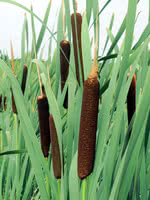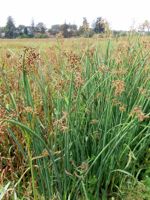Mon-Fri 9am - 5pm Mountain time
Common Cattail vs Softstem Bulrush
Typha latifolia
Schoenoplectus tabernaemontani
CUSTOM GROW
CUSTOM GROW
Cattail is found all across North America, growing next to water. Like other waterside plants, Cattail provides erosion control and forage for animals.
It is suitable for land reclamation. Cattail is able to tolerate cold weather and occasional flooding.
Softstem Bulrush is a native perennial sedge that forms dense colonies of tall, upright stems. Thriving in saturated soils and shallow water, it spreads vigorously by rhizomes, creating large colonies that stabilize shorelines, control erosion, and strengthen wetland ecosystems.
Dense stands of Softstem Bulrush create shelter and nesting sites for birds, while also supporting aquatic invertebrates and the larvae of numerous insects. It is also an important food source. Many wetland birds, especially ducks, feed on the seeds, while muskrats feed on the foliage and rhizomes. Well-suited for ecological restoration, waterside & riparian plantings, erosion control, and habitat enhancement projects.

